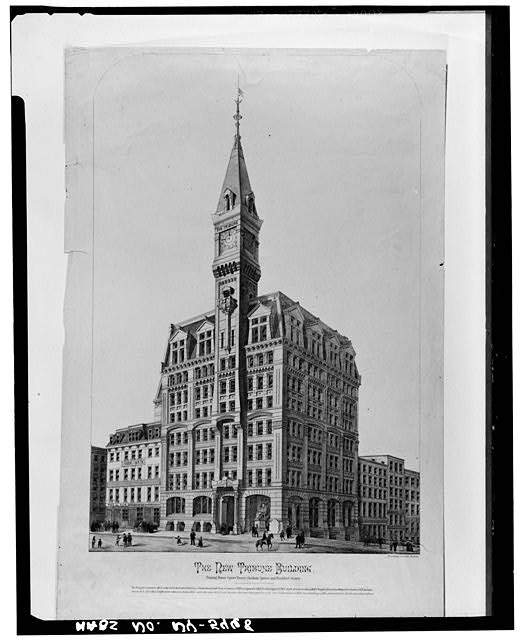|
Tribune Building
1873
Richard Morris Hunt,
architect
Jpg: Library of Congress
Located at 154 Printinghouse Square,
New York, New York; or the northeast corner of Nassau and Spruce Street.
It was part of a group of successful 19th century newspaper buildings fronting
Printinghouse Square and was one of the first buildings with an elevator.[1]
Up to this time buildings were limited
by how many stories people were willing to climb (usually no more than
four) but the the ever growing concentration of the urban centers and the
escalating prices of the underlying land (from supply and demand forces)
the need to go higher was pressing. With the advent of elevators they could
go higher -- to a point. Like the flying buttresses
of the Victorian Gothic cathedrals before them, there was a limit to how
high these buildings of stone and brick could reach. Not so much in the
physical limitations but in terms of economics. As a building grow higher
and taller, a building's lower floors of stone or brick have to become
thicker and bulkier in order to carry the weight of the ever rising upper
floors. The thicker walls made the lower floors less functional and more
costly to construct. At some point the law of diminishing returns would
kick in and make it uneconomically feasible to go any higher. In terms
of the Tribune Building, you can sort of see the thick walls around the
window openings at the first level, and you can imagine how thick some
of the interior load baring walls would have to be. What's not quite as
noticeable is the walls of the floors become less thick as you go higher.
Steel would
be the materiel that would bring on the sky scrapers, and solve the problem
of load baring walls. In fact, with a steel frame, the exterior walls
could be as thin as glass, but that was still a few years to come.[2]
The Tribune building was razed in
1966. Pace Collage now owns the site.
Notes:
-
1) Information from Library of Congress
-
2) John McCrae, Reflection of History
in Construction Material; Real Property Perspectives, American Society
of Appraisers; Spring 1995, pp. 2-7
-
See more on Richard
Morris Hunt
|


